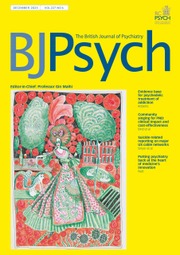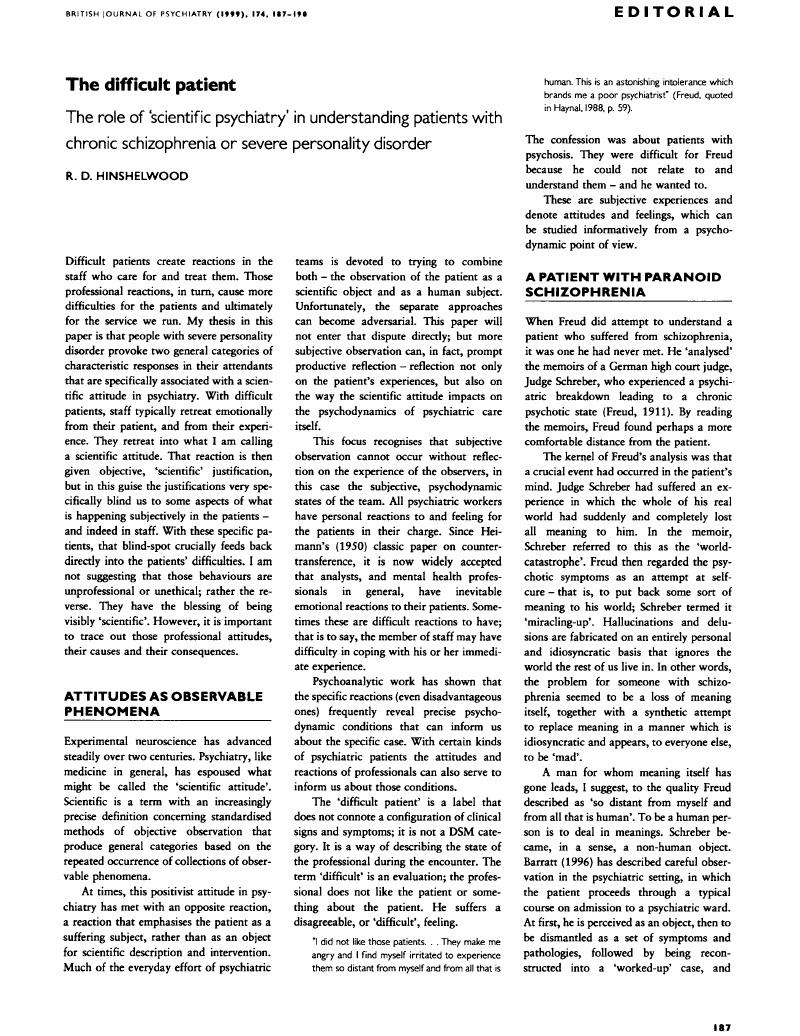Crossref Citations
This article has been cited by the following publications. This list is generated based on data provided by Crossref.
Nathan, R.
1999.
Scientific attitude to ‘difficult’ patients.
British Journal of Psychiatry,
Vol. 175,
Issue. 1,
p.
87.
Simpson, D.
1999.
[No Title].
British Journal of Psychiatry,
Vol. 175,
Issue. 1,
p.
88.
Webster, P.
1999.
‘Scientific’ psychiatry.
British Journal of Psychiatry,
Vol. 175,
Issue. 2,
p.
192.
McCarthy, P.
1999.
The difficult patient – Schreber revisited.
British Journal of Psychiatry,
Vol. 175,
Issue. 3,
p.
290.
Hartman, D.
1999.
Regarding the ‘difficult patient’.
British Journal of Psychiatry,
Vol. 175,
Issue. 2,
p.
192.
Holmes, Jeremy
2000.
NHS PSYCHOTHERAPY ‐ PAST, FUTURE AND PRESENT.
British Journal of Psychotherapy,
Vol. 16,
Issue. 4,
p.
447.
Perris, Carlos
2000.
Personality-related disorders of interpersonal behaviour: a developmental-constructivist cognitive psychotherapy approach to treatment based on attachment theory.
Clinical Psychology & Psychotherapy,
Vol. 7,
Issue. 2,
p.
97.
Hinshelwood, R. D.
2000.
Alienation: Social relations and therapeutic relations.
Psychoanalytic Studies,
Vol. 2,
Issue. 1,
p.
21.
Beales, D.
2001.
Continuing stigmatisation by psychiatrists.
British Journal of Psychiatry,
Vol. 178,
Issue. 5,
p.
475.
Barry, John J.
and
Sanborn, Katherine
2001.
Etiology, diagnosis, and treatment of nonepileptic seizures.
Current Neurology and Neuroscience Reports,
Vol. 1,
Issue. 4,
p.
381.
Hook, John
2001.
The role of psychodynamic psychotherapy in a modern general psychiatry service.
Advances in Psychiatric Treatment,
Vol. 7,
Issue. 6,
p.
461.
Murphy, Denis
2002.
Risk assessment as collective clinical judgement.
Criminal Behaviour and Mental Health,
Vol. 12,
Issue. 2,
p.
169.
Quinn, Brian
2002.
How Psychotherapists Handle Difficult Clients.
The Reference Librarian,
Vol. 36,
Issue. 75-76,
p.
181.
2002.
Introducing Cognitive Analytic Therapy.
p.
245.
Platt, Chris
2002.
Nurses 'Fit for Purpose': Using a task-centred group to help students learn from experience.
Teaching in Higher Education,
Vol. 7,
Issue. 1,
p.
33.
Hinshelwood, R.D.
2002.
Abusive help – helping abuse: The psychodynamic impact of severe personality disorder on caring institutions.
Criminal Behaviour and Mental Health,
Vol. 12,
Issue. S2,
Lavender, Anthony
2002.
Developing services for people with dangerous and severe personality disorders.
Criminal Behaviour and Mental Health,
Vol. 12,
Issue. S2,
Doctor, Ronald
2004.
Psychodynamic lessons in risk assessment and management1.
Advances in Psychiatric Treatment,
Vol. 10,
Issue. 4,
p.
267.
Adlam, John
and
Scanlon, Christopher
2005.
Personality Disorder and Homelessness: Membership and ‘Unhoused Minds’ in Forensic Settings.
Group Analysis,
Vol. 38,
Issue. 3,
p.
452.
Gordon, John
Harding, Sharman
Miller, Claire
and
Xenitidis, Kiriakos
2005.
X-treme Group Analysis: On the Countertransference Edge in Inpatient Work with Forensic Patients.
Group Analysis,
Vol. 38,
Issue. 3,
p.
409.




eLetters
No eLetters have been published for this article.